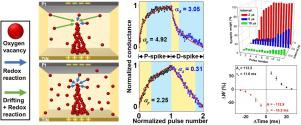Applied Materials Today ( IF 8.3 ) Pub Date : 2020-01-31 , DOI: 10.1016/j.apmt.2020.100582 Jong-Un Woo , Hyun-Gyu Hwang , Sung-Mean Park , Tae-Gon Lee , Sahn Nahm

|
A crystalline NaNbO3 (NN) film was deposited on the TiN/SiO2/Si (T-S) substrate at 300 °C by using the pulsed laser deposition method. The NN film that was annealed at 300 °C under 5 Torr O2 atmosphere displays a typical bipolar switching curve. Growth and dissociation of the oxygen vacancy filament is responsible for the switching property of this NN memristor. This NN memristor shows good biological synaptic properties, but displays a non-linear conductance modulation with the application of an identical pulse. The non-linear conductance modulation is related to the non-linear growth of the oxygen vacancy filament that is controlled by two growth mechanisms (the fast redox process and the slow oxygen ion diffusion process) with different growth rates. The NN memristor was annealed under 10 Torr N2 atmosphere to increase the number of oxygen vacancies, and it displayed improved conductance modulation linearity. The filament in this NN film can be grown linearly and the redox process became the main growth mechanism. Therefore, the conductance modulation linearity can be improved by increasing the number of oxygen vacancies, and this method can be applied to other memristors.
中文翻译:

基于NaNbO 3忆阻器的人工突触电导调制线性的改进。
通过使用脉冲激光沉积方法,在300°C的TiN / SiO 2 / Si(TS)衬底上沉积晶体NaNbO 3(NN)膜。在5 Torr O 2下于300°C退火的NN膜大气显示典型的双极转换曲线。氧空位丝的生长和离解是该NN忆阻器的开关特性的原因。该NN忆阻器显示出良好的生物突触特性,但是在施加相同脉冲的情况下显示出非线性电导调制。非线性电导调制与氧空位细丝的非线性生长有关,该空位细丝的非线性生长由两种生长机制(快速氧化还原过程和缓慢的氧离子扩散过程)以不同的生长速率控制。NN忆阻器在10 Torr N 2下退火气氛增加了氧空位的数量,并且显示出改善的电导调制线性度。NN膜中的长丝可以线性生长,氧化还原过程成为主要的生长机理。因此,可以通过增加氧空位的数量来改善电导调制线性度,并且该方法可以应用于其他忆阻器。


























 京公网安备 11010802027423号
京公网安备 11010802027423号